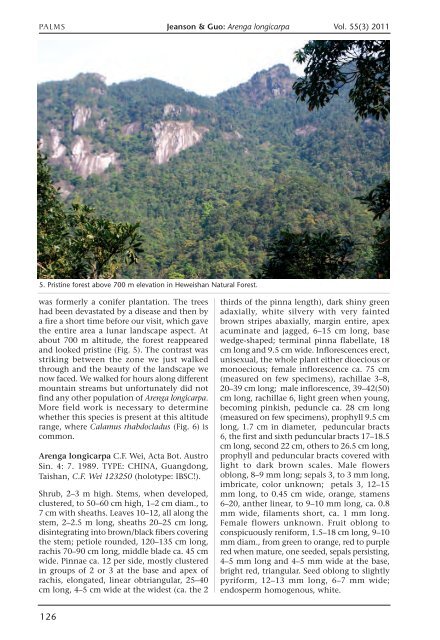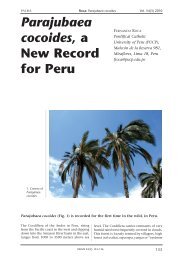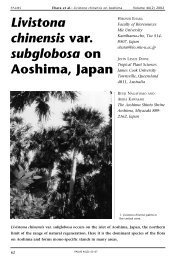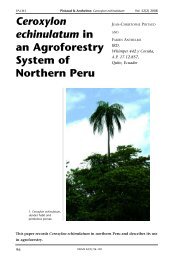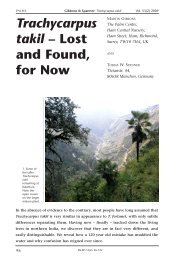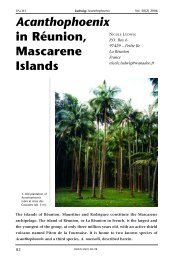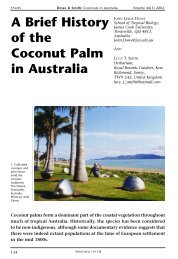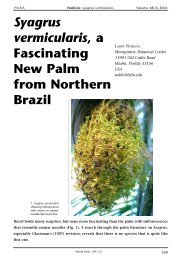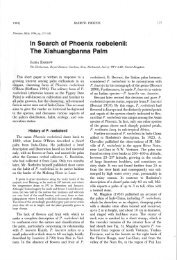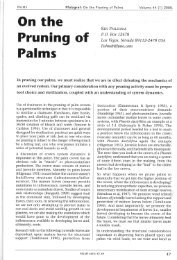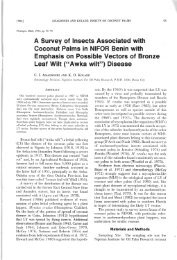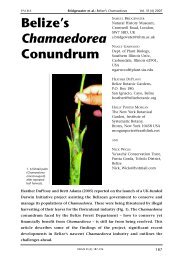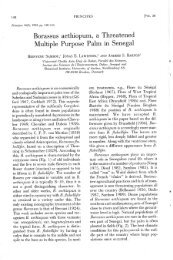Arenga longicarpa, a Poorly Known Species from South China
Arenga longicarpa, a Poorly Known Species from South China
Arenga longicarpa, a Poorly Known Species from South China
You also want an ePaper? Increase the reach of your titles
YUMPU automatically turns print PDFs into web optimized ePapers that Google loves.
PALMS Jeanson & Guo: <strong>Arenga</strong> <strong>longicarpa</strong> Vol. 55(3) 2011<br />
5. Pristine forest above 700 m elevation in Heweishan Natural Forest.<br />
was formerly a conifer plantation. The trees<br />
had been devastated by a disease and then by<br />
a fire a short time before our visit, which gave<br />
the entire area a lunar landscape aspect. At<br />
about 700 m altitude, the forest reappeared<br />
and looked pristine (Fig. 5). The contrast was<br />
striking between the zone we just walked<br />
through and the beauty of the landscape we<br />
now faced. We walked for hours along different<br />
mountain streams but unfortunately did not<br />
find any other population of <strong>Arenga</strong> <strong>longicarpa</strong>.<br />
More field work is necessary to determine<br />
whether this species is present at this altitude<br />
range, where Calamus rhabdocladus (Fig. 6) is<br />
common.<br />
<strong>Arenga</strong> <strong>longicarpa</strong> C.F. Wei, Acta Bot. Austro<br />
Sin. 4: 7. 1989. TYPE: CHINA, Guangdong,<br />
Taishan, C.F. Wei 123250 (holotype: IBSC!).<br />
Shrub, 2–3 m high. Stems, when developed,<br />
clustered, to 50–60 cm high, 1–2 cm diam., to<br />
7 cm with sheaths. Leaves 10–12, all along the<br />
stem, 2–2.5 m long, sheaths 20–25 cm long,<br />
disintegrating into brown/black fibers covering<br />
the stem; petiole rounded, 120–135 cm long,<br />
rachis 70–90 cm long, middle blade ca. 45 cm<br />
wide. Pinnae ca. 12 per side, mostly clustered<br />
in groups of 2 or 3 at the base and apex of<br />
rachis, elongated, linear obtriangular, 25–40<br />
cm long, 4–5 cm wide at the widest (ca. the 2<br />
thirds of the pinna length), dark shiny green<br />
adaxially, white silvery with very fainted<br />
brown stripes abaxially, margin entire, apex<br />
acuminate and jagged, 6–15 cm long, base<br />
wedge-shaped; terminal pinna flabellate, 18<br />
cm long and 9.5 cm wide. Inflorescences erect,<br />
unisexual, the whole plant either dioecious or<br />
monoecious; female inflorescence ca. 75 cm<br />
(measured on few specimens), rachillae 3–8,<br />
20–39 cm long; male inflorescence, 39–42(50)<br />
cm long, rachillae 6, light green when young,<br />
becoming pinkish, peduncle ca. 28 cm long<br />
(measured on few specimens),prophyll 9.5 cm<br />
long, 1.7 cm in diameter, peduncular bracts<br />
6, the first and sixth peduncular bracts 17–18.5<br />
cm long, second 22 cm, others to 26.5 cm long,<br />
prophyll and peduncular bracts covered with<br />
light to dark brown scales. Male flowers<br />
oblong, 8–9 mm long; sepals 3, to 3 mm long,<br />
imbricate, color unknown; petals 3, 12–15<br />
mm long, to 0.45 cm wide, orange, stamens<br />
6–20, anther linear, to 9–10 mm long, ca. 0.8<br />
mm wide, filaments short, ca. 1 mm long.<br />
Female flowers unknown. Fruit oblong to<br />
conspicuously reniform, 1.5–18 cm long, 9–10<br />
mm diam., <strong>from</strong> green to orange, red to purple<br />
red when mature, one seeded, sepals persisting,<br />
4–5 mm long and 4–5 mm wide at the base,<br />
bright red, triangular. Seed oblong to slightly<br />
pyriform, 12–13 mm long, 6–7 mm wide;<br />
endosperm homogenous, white.<br />
126


